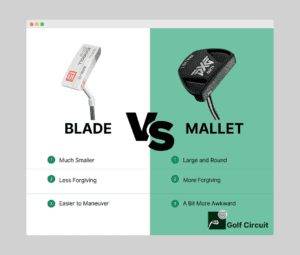The putter is an essential component of each golfer’s golf bag. It may not be as glamorous as the driver or iron, but it is just as important in the game. Indeed, it has been said that “drive for show, putt for dough.” This classic golfing aphorism emphasizes the importance of the putter in a golfer’s success.
Why Having the Right Putter Matters
Just as a painter needs the right brush to create a masterpiece, a golfer needs the right putter to make those crucial short-range shots. The right putter can make a significant difference in a golfer’s game, improving their accuracy and control on the greens.
Fit for Purpose: Putters come in various shapes, sizes, and designs. Each type is designed to suit a specific stroke style. For instance, blade putters are ideal for golfers with an arc stroke, while mallet putters are better suited for those with a straight stroke.
Comfort and Confidence: A comfortable putter gives you confidence on the green. It should feel good in your hands, have the right weight distribution, and align well with your stance and stroke style.
Role of a Putter in Improving Your Game
Accuracy: A good putter can significantly improve your accuracy. Its design can help you align your shots better, leading to more successful putts.
Distance Control: The right putter can also enhance your distance control. Its weight distribution can affect how far the ball travels with each stroke.
Consistency: Consistency is key in golf. The more consistent your putting stroke is, the better your chances of sinking more putts. A putter that suits your style and comfort can help you achieve this consistency.
Here’s a table summarizing the importance of a putter:
| Importance | Explanation |
|---|---|
| Fit for Purpose | Putters come in various shapes, sizes, and designs to suit specific stroke styles. |
| Comfort and Confidence | A comfortable putter gives you confidence on the green. It should feel good in your hands, have the right weight distribution, and align well with your stance and stroke style. |
| Accuracy | A good putter can significantly improve your accuracy by helping you align your shots better. |
| Distance Control | The right putter can enhance your distance control. Its weight distribution can affect how far the ball travels with each stroke. |
| Consistency | Consistency is key in golf. A putter that suits your style and comfort can help you achieve this consistency. |
Understanding Different Putter Types

When it comes to golf, choosing the right putter can make a significant difference in your game. It’s not just about picking the most expensive or the most popular one. It’s about finding the one that fits you perfectly.
Blade Putters: These are classic and straightforward. They are ideal for players who have a smooth stroke and prefer a softer feel on impact.
Mallet Putters: These are larger and offer more stability. If you have a straight-back, straight-through stroke, this might be your best bet.
Perimeter-weighted Putters: These putters distribute weight around the edges of the head, providing a larger sweet spot. They’re great for beginners or those who struggle with consistency.
Face-balanced vs Toe-balanced Putters: The balance of your putter depends on your stroke. If it’s straight-back, straight-through, go for face-balanced. If it’s an arc stroke, toe-balanced could be better.
Remember, the best putter for you is one that feels comfortable in your hands and improves your confidence on the greens. So take your time, try out different types, and find that perfect fit!
Blade Putters
If you’re an avid golfer, finding the right putter can greatly improve your game. One popular type of putter is the blade putter. Here’s an overview of blade putters and some key considerations to help you choose the best one for you.
Blade putters are known for their classic design, with a thin, flat clubhead and a straight shaft. They offer a traditional look and feel, making them a favorite among golf purists. The simplicity of their design allows for better control and precision when putting.
When choosing a blade putter, there are a few factors to consider:
- Alignment: Look for a blade putter that offers alignment aids, such as lines or dots on the top of the clubhead. These aids can help you line up your putt more accurately.
- Weight: Consider the weight of the putter. Some golfers prefer a heavier putter for added stability, while others prefer a lighter one for increased feel and control.
- Length: The length of the putter should be comfortable for your height and posture. Experiment with different lengths to find the one that suits you best.
- Feel: Try out different blade putters to see which one feels best in your hands. The right feel can give you confidence and improve your stroke.
Remember, choosing the best putter is a personal preference, so take your time to test out different options before making a decision. With the right blade putter in hand, you’ll be sinking those putts in no time!
Mallet Putters
When it comes to choosing the best putter for your golf game, there are many factors to consider. One popular option is the mallet putter, known for its larger, more forgiving head shape. Here are some key points to keep in mind when choosing a mallet putter that suits you:
- Alignment: Mallet putters often feature alignment aids such as lines or dots on the top of the clubhead. These aids can help you line up your putts more accurately, increasing your chances of sinking those crucial shots.
- Weight Distribution: Mallet putters typically have a higher moment of inertia (MOI) compared to blade putters. This means that weight is distributed more evenly across the clubhead, resulting in increased stability and forgiveness on off-center hits.
- Feel and Stroke: Mallet putters come in various designs, each with its own feel and balance. It’s important to try out different models to find one that feels comfortable in your hands and complements your putting stroke.
- Personal Preference: Ultimately, choosing a putter is a personal decision. Consider factors such as aesthetics, brand reputation, and any specific features that you prefer.
Remember, finding the right putter can greatly improve your putting performance on the greens. Take the time to test different mallet putters and choose one that gives you confidence and consistency on the green.
Counterbalanced Putters: Features and Benefits
Counterbalanced putters are a relatively new addition to the golfing world but have quickly gained popularity due to their unique design. They feature a heavier clubhead and grip, which shifts the balance point closer to the hands and adds stability throughout the stroke.
The main benefit of counterbalanced putters is their ability to reduce wrist action, promoting a smoother, pendulum-like stroke. This can be particularly beneficial for those struggling with short putts or who tend to get ‘wristy’ in their stroke.
In conclusion, when choosing a putter, it’s essential to consider your skill level, playing style, and personal preferences. Whether it’s the traditional feel of blade putters, the forgiveness of mallet putters, or the stability of counterbalanced putters, there’s a perfect putter out there for everyone.
Considerations When Choosing a Putter

For every avid golfer, the putter is one of the most critical clubs in the bag. It’s the club that can make or break a game, and choosing the right one is paramount. The best putter for you depends on several factors, including your personal preferences, playing style, and physical characteristics.
Putter Length
When it comes to choosing the best putter for your golf game, one important factor to consider is the length of the putter. The right putter length can greatly impact your putting stroke and overall performance on the green. Here’s what you need to know:
The length of a putter affects your posture and alignment, which in turn affects your stroke mechanics. A putter that is too long or too short can throw off your balance and make it difficult to consistently strike the ball accurately.
To determine the ideal putter length for you, consider your height, arm length, and posture. A general rule of thumb is that the putter should allow you to comfortably address the ball with your eyes directly over it and your arms hanging naturally.
If you are taller, you may need a longer putter to maintain proper posture. Conversely, if you are shorter, a shorter putter may be more suitable. It’s also worth noting that there are adjustable putters available that allow you to customize the length to fit your preferences.
Remember, finding the right putter length is a personal preference and may require some trial and error. Take the time to test different lengths and see which one feels most comfortable and natural for you. By choosing the right putter length, you can improve your putting accuracy and consistency on the green.
Putter Weight and Balance
When it comes to choosing the best putter for you, there are several factors to consider, and one of the most important is the weight and balance of the putter. The weight and balance can greatly affect your putting stroke and overall performance on the greens. Here are some key points to keep in mind:
- Weight: The weight of a putter can vary, and it’s essential to find one that feels comfortable in your hands. Some golfers prefer a heavier putter for added stability, while others prefer a lighter putter for increased feel and control. Experiment with different weights to find what works best for you.
- Balance: The balance of a putter refers to how the weight is distributed throughout the clubhead. There are three main types of balance: face-balanced, toe-balanced, and heel-balanced. Face-balanced putters are ideal for golfers with a straight-back, straight-through putting stroke, while toe-balanced putters are better suited for golfers with an arcing stroke. Heel-balanced putters are a middle ground between the two.
Finding the right weight and balance combination can greatly improve your putting consistency and accuracy. It’s recommended to try out different putters and seek advice from a professional club fitter to ensure you find the best fit for your stroke and preferences.
Remember, choosing the right putter is a personal decision, so take your time, experiment, and trust your instincts to find the perfect one that will help you sink more putts on the greens.
Putter Face and Insert Options
When it comes to choosing the best putter for your game, one important factor to consider is the face and insert options available. The face of a putter can greatly impact the feel and performance of your strokes, so it’s crucial to understand the different options and their effects.
There are several types of putter faces and inserts to choose from, each with its own characteristics. Let’s explore some of the most common options:
- Metal Face: Putters with a metal face provide a firmer feel and sound at impact. They are often preferred by golfers who prefer a more solid and responsive feedback.
- Milled Face: Milled faces are crafted with precision using CNC machines. They offer a softer feel and enhanced consistency in ball roll. Many professional golfers opt for milled face putters for their superior performance.
- Inserts: Inserts are typically made from materials like rubber, polymer, or aluminum. They are designed to soften the feel at impact and provide better forgiveness on off-center hits. Inserts can vary in thickness and hardness, allowing golfers to find the right balance between feel and performance.
When choosing a putter face and insert option, it’s essential to consider your personal preferences and playing style. Experimenting with different options during practice sessions can help you determine which combination offers the best feel and performance for your strokes.
Remember, selecting the right putter is a highly individual choice, so take the time to try out various options before making your decision. Happy putting!
Putter Grip

When it comes to improving your putting game, one of the most important factors to consider is the grip on your putter. The right grip can make a significant difference in your ability to control the clubface and make consistent, accurate putts. Here are some key points to help you choose the best putter grip for you:
- Size: Putter grips come in various sizes, ranging from standard to oversized. The size you choose should depend on your hand size and personal preference. A larger grip can help stabilize your hands and reduce wrist movement, while a smaller grip allows for more feel and control.
- Material: Putter grips are typically made of rubber or synthetic materials. Rubber grips offer a softer feel and more traction, while synthetic grips tend to be more durable and resistant to weather conditions.
- Shape: Putter grips come in different shapes, including pistol, paddle, and round. The shape you choose should feel comfortable in your hands and promote a natural, repeatable putting stroke.
- Texture: Grips with texture or patterns can provide additional grip and prevent slipping, especially in wet conditions. Consider a grip with a texture that feels comfortable to hold and provides the right amount of traction for your putting stroke.
Remember, finding the best putter grip for you is a personal preference. Experiment with different options to find the one that feels most comfortable and helps you achieve better control over your putts.
Trial and Testing
When it comes to improving your golf game, finding the right putter is crucial. With so many options available, it can be overwhelming to choose the best one for you. But fear not, we have some tips and suggestions to help you make an informed decision.
- Try before you buy: Take advantage of demo days or visit a local golf store that allows you to test different putters. This hands-on experience will give you a feel for the putter’s weight, balance, and grip, helping you determine what works best for your stroke.
- Consider your stroke style: Are you an arc putter or a straight-back-straight-through putter? Different putters are designed to accommodate different stroke styles. Understanding your stroke style will guide you towards the right putter design.
- Seek professional advice: Consult with a golf instructor or club fitter who can analyze your putting stroke and recommend the best putter for your game. They have the expertise to identify any flaws in your technique and suggest a putter that can help correct them.
- Take note of alignment aids: Look for putters with alignment aids that suit your preferences. Some golfers prefer a simple sightline, while others may benefit from more elaborate alignment features like dots or lines.
Remember, finding the best putter for your game is a personal journey. Take your time, try different options, and trust your instincts. With the right putter in hand, you’ll be sinking those putts in no time!
Assessing Your Putting Stroke

For golf enthusiasts, the putter is one of the most critical clubs in the bag. It can make or break your game on the green. However, choosing the right putter can be a daunting task, especially with the numerous options available in the market. The key to selecting the perfect putter lies in understanding your putting stroke.
Identifying Your Putting Stroke Style
Identify Your Stroke: Every golfer has a unique putting stroke style. Some golfers have a straight back and straight through stroke, while others have an arc stroke. The straight back and straight through stroke is when the putter head moves directly along the target line during the entire stroke. On the other hand, an arc stroke is when the putter head moves slightly inside of the target line on both the backswing and follow-through.
Understand Your Tempo: The tempo of your putting stroke is another crucial factor to consider. Some golfers have a slow and smooth tempo, while others have a fast and aggressive tempo. Understanding your tempo will help you choose a putter that complements your style.
Matching Your Putting Stroke to Putter Type
Choose The Right Putter: Once you’ve identified your putting stroke style and tempo, it’s time to match them with the right putter type. If you have a straight back and straight through stroke, a face-balanced putter would be ideal for you. This type of putter has its weight distributed evenly across the face of the club, which helps keep the clubface square to the target line.
Select The Right Length: The length of your putter also plays a significant role in your putting performance. A putter that’s too long or too short can negatively impact your posture and stroke. Therefore, it’s crucial to choose a putter length that allows you to maintain a comfortable and natural posture.
Here’s a quick guide to help you match your putting stroke to the right putter:
| Putting Stroke Style | Ideal Putter Type |
|---|---|
| Straight back and straight through | Face-balanced putter |
| Arc Stroke | Toe-balanced putter |
Remember, the right putter can significantly improve your performance on the green. Therefore, take your time to understand your putting stroke and choose a putter that complements your style.
Putter Customization Options

The game of golf is one that requires precision, and every golfer knows that the right equipment can make a significant difference in their performance. One of the most crucial pieces of equipment is the putter. But with a plethora of options available, how does one choose the best putter? The answer lies in customization.
Adjustable Putter Weighting and Loft
Adjustable putter weighting and loft are essential customization options to consider when choosing a putter. The weight of a putter can significantly impact a golfer’s stroke. Heavier putters tend to be more stable and can help with control, while lighter putters may provide better feel.
The loft, or angle of the putter face, affects how the ball comes off the club. A higher loft can help get the ball rolling more smoothly on slower greens, while a lower loft may be better for faster greens.
Putter Lie Angle Adjustment
The lie angle is another critical factor in selecting a putter. It refers to the angle between the shaft and the ground when the putter is in its address position. If this angle is not correct, it can lead to mis-hits and inaccurate putts. An adjustable lie angle allows golfers to customize their putter to their stance and stroke style, improving accuracy and consistency.
Putter Shaft Material and Flex
The material and flex of the putter shaft also play a role in choosing the right putter. Different materials offer varying levels of feel and feedback. For instance, steel shafts are known for their durability and consistent performance, while graphite shafts are lighter and can provide better vibration dampening.
The flex of the shaft affects how much it bends during the stroke. A stiffer shaft provides more control, while a more flexible shaft can offer better feel.
In conclusion, choosing the best putter involves considering several factors, including adjustable weighting and loft, lie angle adjustment, and shaft material and flex. By understanding these customization options, golfers can select a putter that best fits their game and helps them perform at their best.
Here’s a table to recap:
| Customization Option | Explanation |
|---|---|
| Adjustable Putter Weighting and Loft | Allows golfers to control the stability and feel of their putter, as well as how the ball comes off the club. |
| Putter Lie Angle Adjustment | Enables golfers to customize their putter to their stance and stroke style, improving accuracy and consistency. |
| Putter Shaft Material and Flex | Different materials offer varying levels of feel and feedback, while the flex affects how much the shaft bends during the stroke. |
Putter Budget and Price Range

For the devoted golfer, the putter is more than just a club; it’s an extension of their arm. The right putter can make all the difference in a game, improving accuracy, control, and confidence on the green. However, finding the perfect putter can be a daunting task, especially when considering the budget and price range.
Determining Your Budget for a Putter
Before you start shopping for a putter, it’s crucial to set a budget. Golf equipment can be expensive, and putters are no exception. Prices can range anywhere from $20 to $500 or more, depending on the brand, quality, and features.
Establishing a clear budget helps narrow down options and prevents overspending. It’s essential to remember that while an expensive putter may offer advanced features or materials, it doesn’t necessarily guarantee a better game. What matters most is how well the putter fits your playing style and comfort.
Finding Value in Different Putter Price Ranges
Once you’ve determined your budget, you can start exploring different price ranges and what they have to offer.
1.Low-End Putters: These are typically priced under $100. While they may lack some of the advanced features found in higher-priced models, they can still provide a decent performance for beginners or casual players.
2.Mid-Range Putters: Ranging from $100 to $200, these putters often offer a balance between cost and quality. They may feature better materials or design elements that improve balance and feel.
3.High-End Putters: Priced over $200, these are often crafted with premium materials and boast advanced features like custom fitting options or innovative design elements. These are typically favored by serious or professional players.
Here’s a table to summarize the value in different putter price ranges:
| Price Range | Value |
|---|---|
| Low-End Putters | – Priced under $100: Ideal for beginners or casual players. – May lack advanced features but still provide decent performance. |
| Mid-Range Putters | – Priced between $100-$200: Offers a balance between cost and quality. – May feature better materials or design elements that improve balance and feel. |
| High-End Putters | – Priced over $200: Crafted with premium materials and advanced features like custom fitting options or innovative design elements.- Ideal for serious or professional players who are willing to invest in their game. |
Remember, the best putter for you is one that fits your budget, playing style, and comfort level. Happy putting!
How to Choose the Right Clubhead Balance for Your Putter?
When it comes to choosing the right putter for you, one important factor to consider is the clubhead balance. The clubhead balance refers to the distribution of weight in the putter head, and it plays a crucial role in how the putter feels and performs.
There are three main types of clubhead balance: face-balanced, toe-balanced, and toe-heel balanced. Face-balanced putters have the weight evenly distributed throughout the head, making them suitable for golfers with a straight-back, straight-through putting stroke. Toe-balanced putters have more weight in the toe, which is ideal for golfers with an arcing putting stroke. Toe-heel balanced putters have weight concentrated in the toe and heel, providing a balance between face and toe-balanced putters.
To determine which clubhead balance is best for you, consider your putting stroke and your personal preference. If you have a straight-back, straight-through stroke, a face-balanced putter may work well for you. If you have an arcing stroke, a toe-balanced putter might be a better choice. If you prefer a balanced feel, a toe-heel balanced putter could be the right fit.
Remember, choosing the right clubhead balance is all about finding what feels comfortable and natural for your putting stroke. Experiment with different options and see which one gives you the best results on the greens.
What is the best putter for beginner golfers?
| Putter | Brand | Shape | Size | Weight | Feel | Technology |
|---|---|---|---|---|---|---|
| Odyssey White Hot OG 2-Ball Putter | Odyssey | Blade | 35 inches | 350 grams | Soft | White Hot insert with Microhinge technology |
| TaylorMade Spider Tour Black Putter | TaylorMade | Mallet | 35 inches | 375 grams | Stable | Large head with sightline |
| Cleveland Huntington Beach Soft Putter | Cleveland | Blade | 35 inches | 350 grams | Responsive | Soft steel face |
| Wilson Harmonized M3 Putter | Wilson | Mallet | 35 inches | 350 grams | Good value | Face insert with smooth roll, weighted shaft |
| Ping Sigma 2 Anser Putter | Ping | Blade | 35 inches | 350 grams | Classic | Milled face with consistent roll, lightweight shaft |
| Odyssey Tri-Hot 5K Putter | Odyssey | Mallet | 35 inches | 360 grams | Stable | Tri-Hot insert with face balancing |
When it comes to choosing a putter as a beginner golfer, there are a few factors to consider. First and foremost, you want to find a putter that feels comfortable in your hands and gives you confidence when addressing the ball. This means finding a putter with a grip that suits your preference and a weight that feels balanced to you.
Beginner golfers often struggle with consistency in their putting stroke, so it may be helpful to look for a putter with alignment aids. These can be lines or dots on the putter head that help you line up your shots more accurately. A putter with a larger head or a mallet style putter can also provide more stability and forgiveness for those just starting out.
Lastly, consider your budget. While there are many high-end putters on the market, there are also plenty of affordable options that can work just as well for beginner golfers. Don’t be swayed solely by brand names or price tags – focus on finding a putter that feels right for you and improves your confidence on the greens.
What is the best putter for the average golfer?
| Putter | Brand | Shape | Size | Weight | Feel | Technology |
|---|---|---|---|---|---|---|
| Odyssey White Hot OG 2-Ball Putter | Odyssey | Blade | 35 inches | 350 grams | Soft | White Hot insert with Microhinge technology |
| TaylorMade Spider Tour Black Putter | TaylorMade | Mallet | 35 inches | 375 grams | Stable | Large head with sightline |
| Cleveland Huntington Beach Soft Putter | Cleveland | Blade | 35 inches | 350 grams | Responsive | Soft steel face |
| Wilson Harmonized M3 Putter | Wilson | Mallet | 35 inches | 350 grams | Good value | Face insert with smooth roll, weighted shaft |
| Ping Sigma 2 Anser Putter | Ping | Blade | 35 inches | 350 grams | Classic | Milled face with consistent roll, lightweight shaft |
Choosing the best putter for the typical golfer involves several criteria. Comfort and sensation should come first. A confident, comfortable putter will enhance your putting.
Second, consider your stroke type. A blade putter with a small toe hang may be preferable for a straight-back, straight-through stroke. However, an arced stroke may benefit from a mallet putter with a high MOI and toe-balance.
Additionally, putter alignment aids should be explored. Find a putter with obvious alignment lines or dots to assist you line up your putt.
Consider your finances last. There are high-end and cheap putters with amazing performance.
The ideal putter for the ordinary golfer is comfortable, meets your stroke style, provides good alignment aids, and fits your budget. You can locate the right putter by trying several ones and receiving professional assistance.
Conclusion
Choosing the perfect putter can be a game-changer for any golfer. The right putter can enhance your game, improve your strokes, and ultimately lower your scores. But with a plethora of putters available in the market, making the right choice can be daunting.
Key Considerations for Choosing the Best Putter
1. Length: The length of the putter is crucial. It should match your height and stroke style. A putter that’s too long or too short can affect your stance and swing.
2. Weight: The weight of the putter head influences the feel and control of the stroke. A heavier head provides more stability but less feel, while a lighter one offers more feel but less stability.
3. Balance: Putters come in two types: face-balanced and toe-balanced. Face-balanced putters are ideal for players with a straight putting stroke, while toe-balanced ones are suitable for those with an arc stroke.
4. Grip: Grips vary in size and material. A larger grip can help reduce wrist action, enhancing stability, while a smaller grip offers more feel.
| Consideration | Explanation |
|---|---|
| Length | Should match your height and stroke style |
| Weight | Influences the feel and control of the stroke |
| Balance | Face-balanced for straight strokes, toe-balanced for arc strokes |
| Grip | Size and material affect wrist action and feel |
Final Tips for Enhancing Your Putting Game
1. Practice: No matter how perfect your putter is, without practice, improvement is impossible. Regular practice helps you understand your putting style better.
2. Custom Fitting: Consider getting a custom-fitted putter. It ensures that the putter matches your style and physique, enhancing your performance.
3. Experiment: Don’t be afraid to experiment with different putters. What works for one golfer might not work for you.
| Tips | Explanation |
|---|---|
| Practice | Regular practice is key to improvement |
| Custom Fitting | Ensures the putter matches your style and physique |
| Experiment | Try different putters to find what works best for you |
With these tips and considerations, finding the best putter should be less of a challenge. Remember, the right putter is one that feels good in your hands and improves your game. Happy golfing!

I’m Donna Weiss, and I am the proud writer behind the captivating content you’ll find on golfneedy.com. As an avid golfer and passionate writer, I have combined my two greatest passions to bring you an incredible golfing experience. Through my articles, I aim to provide you with valuable insights, equipment reviews, and updates on the latest tournaments. Whether you’re a seasoned golfer or just starting out on this exciting journey, I am here to guide you and share my expertise. Together, let’s explore the fascinating world of golf, uncovering new techniques, and enhancing our skills. Join me on this thrilling adventure as we elevate our game and embark on an exciting golfing journey. Read More



